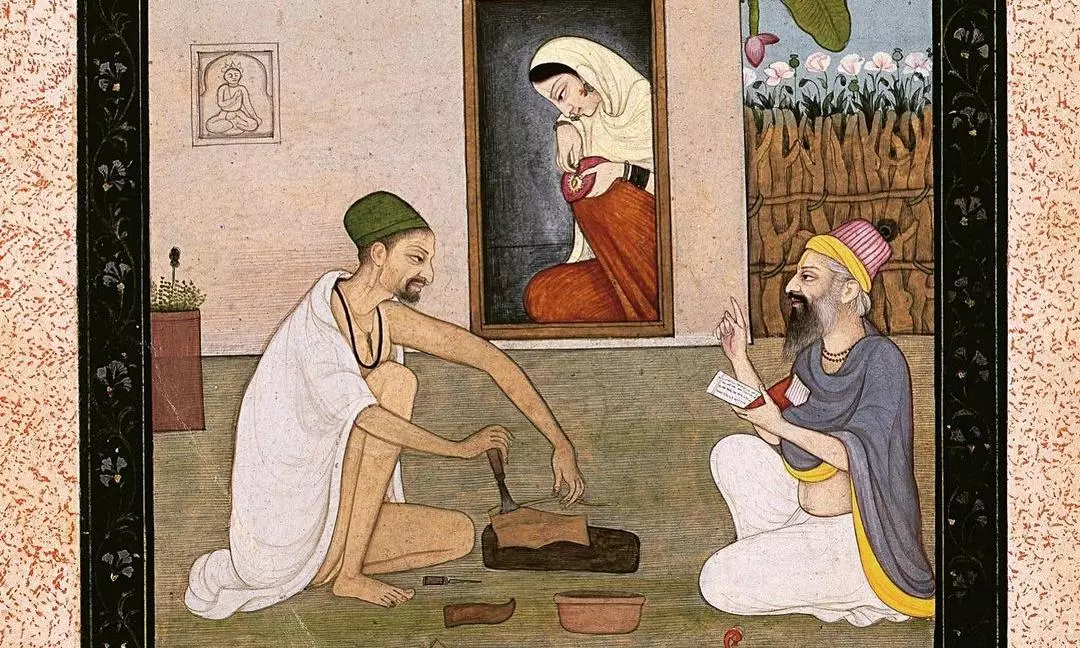
- Home
- India
- World
- Premium
- THE FEDERAL SPECIAL
- Analysis
- States
- Perspective
- Videos
- Sports
- Education
- Entertainment
- Elections
- Features
- Health
- Business
- Series
- In memoriam: Sheikh Mujibur Rahman
- Bishnoi's Men
- NEET TANGLE
- Economy Series
- Earth Day
- Kashmir’s Frozen Turbulence
- India@75
- The legend of Ramjanmabhoomi
- Liberalisation@30
- How to tame a dragon
- Celebrating biodiversity
- Farm Matters
- 50 days of solitude
- Bringing Migrants Home
- Budget 2020
- Jharkhand Votes
- The Federal Investigates
- The Federal Impact
- Vanishing Sand
- Gandhi @ 150
- Andhra Today
- Field report
- Operation Gulmarg
- Pandemic @1 Mn in India
- The Federal Year-End
- The Zero Year
- Science
- Brand studio
- Newsletter
- Elections 2024
- Events
- Home
- IndiaIndia
- World
- Analysis
- StatesStates
- PerspectivePerspective
- VideosVideos
- Sports
- Education
- Entertainment
- ElectionsElections
- Features
- Health
- BusinessBusiness
- Premium
- Loading...
Premium - Events

One is the powerful ‘we’, who claim ownership over it, and the other is the weak 'they', who are its victims
Sanatana Dharma is a metaphor hinged on two uneven limbs, with two disparate dimensions: the powerful ‘we,’ who claim ownership over it, and the weak “they”, who are its victims.
For the “we,” it symbolises sacred time and space (referred to by Romanian historian-philosopher Mircea Eliade as illud tempus, meaning ‘now and always’). It represents an imaginary state in the distant past. It is that which is politically potent in the promise of a future likeness of the imagined originary state. The two positions become clear when we examine statements made by representatives of the ‘we’ and the ‘they’.
Let us begin with Narendra Modi, the Prime Minister. Modi says: “By wiping off Sanatana Dharma, they (“they”)...intend to push the country towards...slavery once again.” He makes an attempt to evoke the positive power of sacred time and space and contrasts it with the “slavery” that would result if one did not protect Sanatana Dharma. A metaphor acquires power as it moves away from reality. But reality is messy and entropic. Metaphor exalts; reality reduces.
When Modi, hoping to leverage the metaphor, speaks of Sanatana Dharma as a reflection of Dalit icon Saint Ravidas, he ends up with the entropic – the down to earth. Ravidas, in fact, opposed the rigid hierarchies and repressive practices of the Brahminical order. He lamented that he was born in a community which traditionally carried out carrion from the village confines.
Appropriating a bard
Ravidas is a Sanskritised form of Raidas. Scholars say name changing is one way to appropriate the bard and endorse the varna hierarchy. A story, they say, was constructed that he was a Brahmin in his past birth. Indiscretions caused him to be born in a leather worker’s family in the next birth. It was the residue of the Brahmin’s intelligence that shone through in his poetry. Otherwise, it was implied, how could a lowly leatherworker possess such talent?
But, ironically, for this reading of him, Raidas’s verses are uncompromisingly critical of the Brahminical system and there is much lament about his poverty and how people taunted him because of it. His bardic verses are a stark revelation of a state of mind that is forced to endure a lowly position in a hierarchical society. Here are some examples:
By caste I am they/That carry carrion/From in and about/The city of BanarasMy caste is low/My work is low/And low, my very being
'(A crime it is/To be born low/Where I go there I find/Heaps of doleful sorrow/People of means/They laugh/At my poverty/And they taunt/Gleefully/Such is destiny mine')
[Dalit Mukti Ki Virasat: Sant Ravidas by Dr Subhash Chandra, pp 12, 14, 17, 79]
Two scholars with opposing views have this to say about Raidas’s poetry. Acharya Ramachandra Shukla dismisses the aesthetic quality of the verses: “[These…] verses do not have literary merit… They are irregular and one does not even get a hint of the sophistication of thought, depth or voice that one would expect from good writing.”
Kanwal Bharti takes the opposite view: “Scholars in the mould of Shukla do not know that the verses of these Dalit sants have been compiled in the Guru Granth Sahib and have been set to raga music. The verses of Kabir and Ravidas...attract musicians and audiences alike and hold them spellbound by their transcendental spiritual appeal. Would these have been possible if they had not possessed intrinsic musicality?"
Metaphor and the Mahatma
In speaking of Mahatma Gandhi’s movement against untouchability, Modi hopes to invoke the metaphoric power of Sanatana Dharma but examining Gandhi’s life and comments, we see how the messy entropy puts a halter on the flight of the metaphor.
Mahatma Gandhi lived a life of transparency and championed nonviolence as a means to settle disputes. He lived his life as if he were living in sacred time and space. By invoking Gandhi, Modi seeks to exalt Sanatana Dharma and show his political opponents in a bad light. But, in fact, Gandhi called for a collapse of the hierarchies. He said: “[To those who claim Sanatana Dharma as their legacy], I ask of you nothing less than this that you should believe in the fundamental unity and equality of man…[and] forget that there are any distinctions of high and low among the children of one and the same God.” [The Collected Works of Mahatma Gandhi (1958-94).]
On the other hand, Gandhi told the untouchables: "No lasting progress can be achieved unless we put ourselves through a…process of purification. I, therefore, ask you now to take a vow from this moment to renounce eating carrion...not to eat the thrown-out crumbs. We will attain self-elevation only if we learn self-help, regain our self-respect, and gain self-knowledge."
Mohan Bhagwat, the chief of RSS, sharpens the distinction between the “we” and the “they” when he makes a confession of the misdeeds of the “we”: “We didn’t care if they lived like animals for 2,000 years. We should be willing to atone for their guilt for 200 years, if need be.”
Let us look at the statements made on behalf of the “they,” the subjects, the victims of the Sanatana Dharma. Udhayanidhi Stalin made the following remarks: “In the same way that we don’t simply oppose mosquitoes but seek to eradicate them — and thereby the diseases they cause — we must likewise eradicate Sanatana Dharma.”
What carries dengue is the mosquito; what carries the disease in Sanatana Dharma is the varna system and its inequities. Those inequities must go; the varna system must go for Santana Dharma to be meaningful to all. Only then would the promise of a future sacred time and space make sense. Stalin, the Chief Minister of Tamil Nadu, defends Udhayanidhi Stalin: “We have a need to challenge superstitions, blind beliefs and remain committed to social justice.”
The reality check
Sanatana Dharma as a reference to religion, scholars say, is of recent vintage. The idea of a four-tier societal order runs in a parallel between the Indian Vedas and the Iranian gathas. Both have no place for idols or temples and both enjoin fire maintenance and sacrifice. The four varnas of the Vedas may have roots in the four pistras (classes) of early Iranian society.
This is of interest because excavations at Indus Valley and post Indus Valley sites have revealed artefacts hinting at a proto-Buddhist culture. Indeed, it is speculated that the Buddha of history may be one in a line of Buddhas. The relics of Bharhut and Ajanta and Ellora reveal seven Buddhas with Gautama as the seventh. Indus Valley sites feature stupa-like structures found at Buddhist sites. [Baudh Sabhyata Ki Khoj by Dr Rajendra Prasad Singh.]
Also, they point out that none of the purported reform movements launched in the 19th century refers to a religious order. Not Raja Ram Mohan Roy (Brahma Samaj), not Dayananda Saraswati (Arya Samaj) and not the promoters of offshoots such as Parivarthana Samaj, among others.
Sanatana Dharma occurs in the Dhammapadam, a text compiling the teachings of Gautama Buddha. A Pali verse says:
Na Hi Verena Verani Sammanti Kudachana
Averena Ca Sammanti Ais Dhammo Sanatana
'Enmity is never ended through enmity/Only by letting go — (and forgiving)
Does it end/This is Sanatana Dharma'
[The Dhammapada: A new translation of the Buddhist Classic with annotations; by Gil Fronsdal, Shambhala, 2011]
Dharma in Buddhist tradition means piety. A Greek rock inscription of Asoka dated 260 BCE — the Kandahar Edict of Asoka — exhorts people to not kill human or animal. Dharma is translated as the Greek word eusebia meaning piety and goodness — not religion. The Greek word for religion in use today is threskeia.
A patent use of Sanatana Dharma as referring to Hindu religion was made by Dr Anne Besant of the Theosophical Society. She founded the Central Hindu College at Banaras in 1898 with a view to impart sound secular education, combined with moral and religious instruction, based on the fundamental tenets of Hinduism. A tract published by the Central Hindu College was titled Sanatana Dharma: An Elementary Text-book of Hindu Religion and Ethics. The foreword says: “The object …[is] to combine Hindu religious and ethical training with the western education…, it is necessary that this religious and ethical training shall be of a wide, liberal and un-sectarian character while at the same time it shall be definitively and distinctively Hindu…” The book defines Sanatana Dharma as the Eternal Religion… given to men many long ages ago.
(The Federal seeks to present views and opinions from all sides of the spectrum. The information, ideas or opinions in the articles are of the author and do not necessarily reflect the views of The Federal.)


